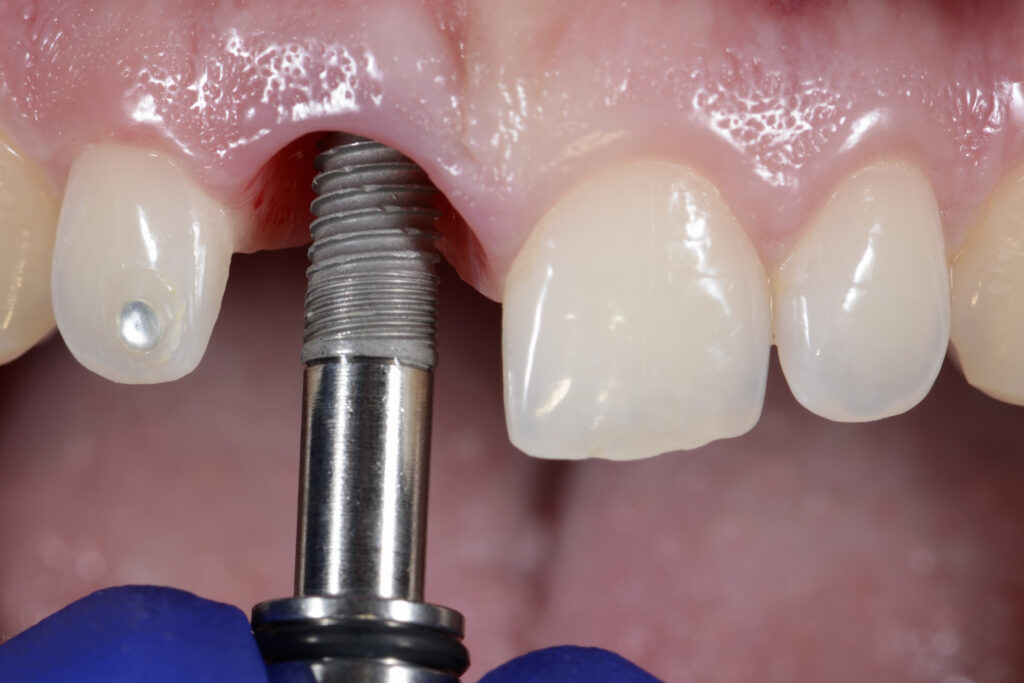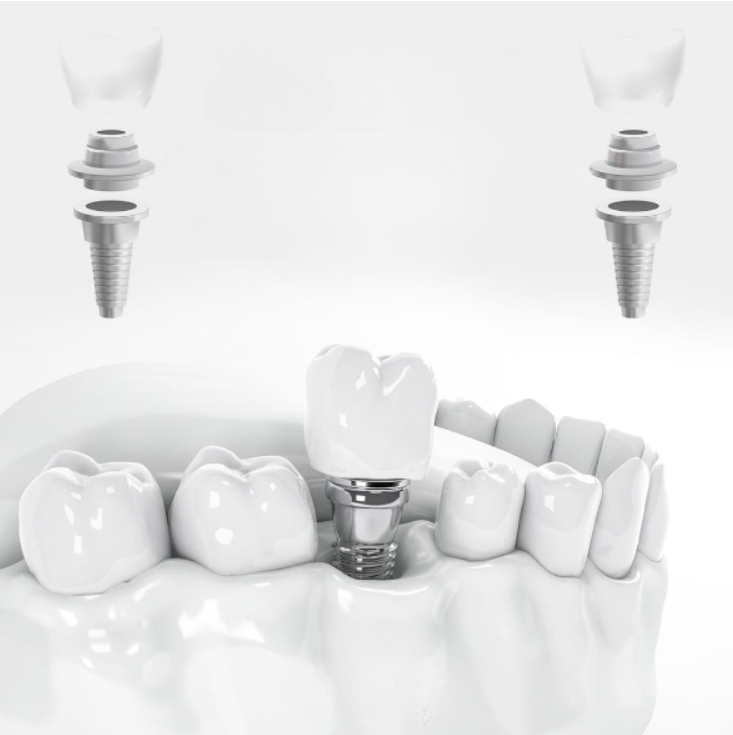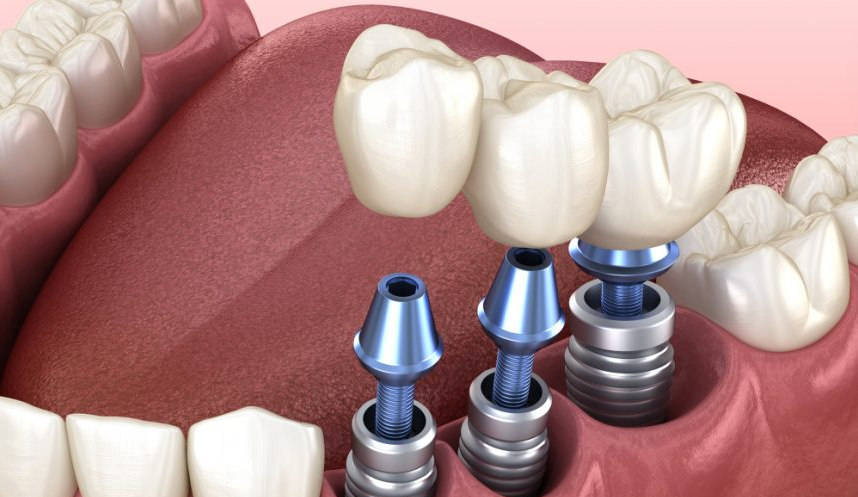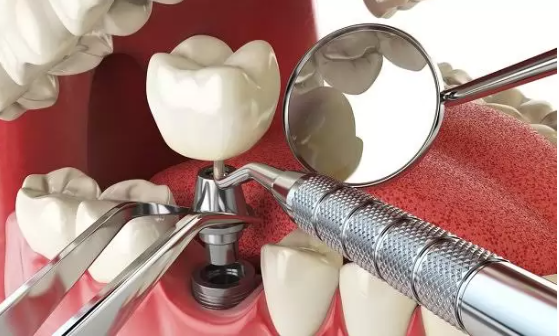What is implant?
Implants are artificial tooth roots used to replace missing teeth and are placed into the jawbone. They are typically made from titanium alloy, although varieties made from zirconium are also available today. They can be used in many cases, ranging from a single missing tooth to complete toothlessness. Research into dental implant procedures, commonly referred to as screw-in teeth, tooth implants, or artificial tooth roots, began in the 1960s. The main reason for the popularity of implantology is that it produces much more aesthetic and comfortable treatment results compared to traditional dentistry methods, such as bridges supported by teeth and total or partial dentures, which are used to replace lost teeth. Offering a wide range of treatment options, implants can be safely used to treat all types of tooth loss (single tooth loss, multiple tooth loss, or complete tooth loss). The most important step before implant placement is for the dentist to present treatment options, taking into account the patient’s general health, clinical and radiographic evaluations, and the patient’s wishes.

Contents
What is Implant Treatment? What are the Stages of Implant Treatment?
Implant treatment is a dental method that provides a permanent and aesthetic solution to tooth loss problems. With titanium implants and special prostheses, patients gain a functional and attractive dental prosthesis to replace their lost teeth. Patients experiencing tooth loss today often prefer implants, which serve as artificial tooth roots. It is possible to regain lost teeth with fixed or removable prostheses supported by implants. Whereas previously, in cases of single tooth loss, the adjacent teeth were cut down to make a bridge to close the gap, now, thanks to dental implants, the gap can be filled by placing an implant in the existing space without cutting the teeth. In cases of complete tooth loss, when implant treatment was not available, the use of removable dentures, also known as dentures, was often difficult for patients. Especially in the lower jaw, where there is no supporting surface, the movement of the denture while chewing and speaking reduced patient comfort. Today, in such cases, depending on the patient’s preference and the amount of bone available, implant-supported removable or fixed dentures can be made.
Implant treatment is a treatment protocol completed in the following stages:
Diagnosis and radiological evaluation:
First, the patient's teeth and gum condition are assessed, and suitability for implant placement is evaluated. Subsequently, radiological suitability must be assessed. Although a simple panoramic film may suffice for preliminary evaluation, three-dimensional dental tomography is required to visualise details and minimise potential complications. Bone thickness and quantity must be measured. Next, the hard and soft tissues that will support the implant and prosthesis must be evaluated. The need for augmentation (bone grafting) depending on tooth positions must be determined. The patient's systemic disorders, chronic diseases, smoking habits, and allergy history must be evaluated in detail. The patient must be informed about the brand of the implant, the techniques to be used, and the prosthesis to be placed on top.
Surgical stage:
At this stage, the dentist assesses the condition of the patient's teeth and gums, and the implants are placed in the body. Once placed, the implants are accepted by the body and begin to bond with the bone. A certain period of time is required for the implants to heal and bond completely with the body. The surgical stage is the beginning of the implant treatment process and helps the patient permanently resolve their tooth loss problem. For implant surgery, the patient's teeth and gums must be properly assessed. The type and size of the implant should be selected according to the patient's teeth and gums. Implant surgery must be performed correctly, and aseptic conditions must be maintained during surgery. Sufficient time must be allowed for the implants to heal and fully integrate into the body.
Prosthesis stage:
This is the final stage of the implant treatment process. At this stage, prostheses that are specially designed and manufactured are placed on the implants inserted into the patient's mouth. As the prostheses are fully bonded to the implants and accepted by the body, they completely fill the gaps in the patient's mouth and help the patient regain normal eating and speaking functions. The prostheses must be correctly placed by the dentist and designed to suit the patient's teeth and gum condition. The implant-supported prosthesis stage helps the patient permanently resolve their tooth loss problem and completely fill the gap in their mouth.
The implant must be placed in the correct anatomical position without compromising surgical and biological principles. The next step is to determine whether the implant should be loaded immediately or at a later stage. During the restoration phase, success can be achieved by ensuring the pre-determined and approved shapes, sizes, and positions of the teeth. By understanding and adhering to these principles, it is possible to predict which treatment will be successful. This treatment protocol must be followed with the same precision at every stage to achieve a successful outcome.
Who Can Have an Implant? When Is It Risky?
Implant treatment is generally suitable for patients who have lost teeth, have completed jaw development, are over 18 years of age, have no systemic diseases that would prevent treatment, and do not have gum disease. However, each patient’s teeth and gums are different, and only a dentist can assess whether they are suitable for implant treatment.
Implant surgery should be avoided in the following circumstances:
- Uncontrolled diabetes patients. Individuals with unregulated blood sugar levels and an HbA1c value above 7.
- Individuals who smoke excessively.
- Individuals under the age of 18 whose jaw development is not complete.
- Individuals who do not have sufficient bone for implant placement.
- Individuals with allergic reactions to metallic materials
- Individuals with poor dental and gum health and inadequate oral hygiene
- Individuals with systemic conditions such as cardiovascular disease that do not permit the procedure

How long do implants last?
There are several factors that affect the lifespan of an implant:
The dentist must develop a good treatment plan.
The patient’s jawbone structure must be properly diagnosed and the correct surgery performed.
The implant-supported prosthesis must be correctly made.
One of the most important points is that the patient maintains maximum oral hygiene.
This includes brushing teeth, using dental floss, and using a mouthwash.
Attending regular check-ups with the dentist are some of the factors that affect long-term health and success. When favourable conditions are met, the goal is for the implants to last a lifetime.
The lifespan of implants depends on many factors, including the patient’s dental and gum health, the proper placement of the implants, their follow-up, and maintenance. Generally, implants that are properly maintained and followed up can last for years and can be used throughout the patient’s lifetime. However, over time, implants may need to be replaced or repaired. Regular dental check-ups and proper care are very important for extending the lifespan of implants.
Implant treatment is a multi-stage treatment protocol whose success depends on each stage being carried out with precision. The success of implant treatment depends on many factors. To summarise these briefly:
- Dental and gum health: Dental and gum health issues such as gum disease, tooth loss, and tooth decay can negatively affect the success of implant treatment.
- Implant placement technique: The proper placement and configuration of implants directly affects the success of implant treatment.
- Implant brand: The structure, quality, and durability of implants can affect the success of implant treatment. Implant brands are important. Working with implant brands that have been around for many years will be safer. Brands that have been tracking their success through case studies dating back many years and continue to innovate are very successful in both implant and superstructure options.
- Patient care: Regular cleaning of implants, attending dental check-ups and repairing them when necessary positively affects the success of implant treatment.
- Dentist’s experience and skill: The experience, skill and application technique of the dentist performing the implant treatment can affect the success of the implant treatment.
- Smoking status: Smoking can negatively affect the success of implant treatment.

What are the types of implant-supported prostheses?
Implant-supported prosthesis planning should be tailored to the patient. The decision should be made by evaluating the patient’s bone, lip, and soft tissue support as a whole. Fixed or removable prostheses can be made. For fixed prostheses, metal-supported prostheses or zirconium-based prostheses can be selected. Removable prostheses can also be used for implant-supported planning. The choice should be based on the number of implants and the condition of the soft tissue support.
When is the timing for implant-supported prosthesis?
Depending on the condition of the implant site, the nature of the surgery performed, and the primary stability after implant placement, surgery may be performed immediately after surgery or after waiting 3-6 months for osseointegration.
Can an implant be placed after tooth extraction? Is it necessary to wait?
The decision must be made based on the condition of the area where the tooth extraction was performed. An implant can be placed immediately after extraction. However, certain conditions must be met for this. The extracted tooth must not be inflamed, and there must be no lesion at the root tip. After extraction, there must be sufficient bone to provide support for the implant screw. For this, it is important that the tooth extraction is performed atraumatically. If these conditions are not met, the implant should be placed 2-3 months after the tooth extraction socket has filled with bone.
What Should Be Done After Implant Surgery?
- Post-operative care; Bleeding may occur in the first few hours after implant surgery. A tampon may be applied to prevent this bleeding.
- On the first day, a cold gel compress should be applied or ice wrapped in a towel should be used to intermittently cool the surgical area. This prevents swelling. Nothing should be consumed for the first 2 hours.
- Avoid excessively hot or cold foods for the first 2 days.
- Gargling will be beneficial from the second day onwards.
- Medications prescribed by the doctor after the operation should be taken without fail.
Routine care; When caring for your implants, you should take care to use dental floss and mouthwash in addition to brushing.
- We recommend that our patients use a mouthwash.
- After brushing your teeth with a mouthwash device, rinsing helps remove food debris trapped under the edges of dentures.
- You should avoid using forceful movements when brushing your teeth or using dental floss.
- If you are looking for an implant centre, we welcome you to our Oral and Dental Health Clinic in Kartal, Istanbul.
How Long Does Recovery Take After an Implant?
Gum healing in the treated area is rapid. The tissue brought together with stitches will fuse within 7-10 days. Your oral hygiene and care, and paying attention to recommendations, are important for this healing speed. Depending on sensitivity to ice application, slight swelling may occur after the implant. This is not a problem. There may be some pain and soreness for a few days after the implant. Prescribed painkillers will be sufficient. The process of the implant fusing with the bone, i.e. the osseointegration period, varies from person to person and takes approximately 2-5 months. However, no change is observed in the gums in the area during this stage.
Does it hurt after the implant is placed?
Ultimately, it is a surgical procedure. When performed appropriately and atraumatically, there may be slight bleeding and pain. The painkiller you will be given will be sufficient. The antibiotics prescribed after the operation should be taken regularly until the last tablet. If you do not feel any pain after the second day, there is no need to take painkillers.
How long after the implants are placed are the teeth made?
Thanks to advanced surface structures, teeth can be placed immediately after implant placement. However, there are numerous factors to consider, such as the surface structure, the condition of the extracted area, bone structure, and the patient’s chewing habits. It is a successful option when the appropriate conditions are met. In the other, more traditional method, a period of 2-5 months is required after implant placement. During this period, the implant remains beneath the gumline, and the patient can continue with their normal daily activities. Temporary dentures can be fitted for all edentulous patients. After the waiting period, the implants are exposed, and following the impression stages, the teeth are placed in their positions.

Could the body reject the implant? Could the implant fall out? How long does it last?
Titanium is a material that has been used in the human body for many years and has been proven through research to be compatible with bone structure. It is even used in bone fractures outside the mouth. There are factors related to the dentist and the patient that influence the success of an implant. It is the dentist’s responsibility to provide the patient with an implant that is suitable for their mouth structure and that they can use properly, and to place the prosthesis on it.
Supporting this work with good oral hygiene and care is also the patient’s responsibility. Dental check-ups every six months are important. It is impossible to predict the exact lifespan, but under ideal conditions, there are many implants that remain successful in the mouth for many years. As with tooth loss due to gum problems, if proper care is not taken, the gums become inflamed and begin to affect the bone around the neck of the implant. If this continues, the implant may also be lost.
What is a Guaranteed Implant?
Some implant brands guarantee that a new implant will be fitted if a problem arises with the original one. Our clinic works with implant companies that meet these conditions.
How Many Parts Does an Implant Consist Of?
The implant consists of two mechanical parts. The part that can be described as a screw, which is placed into the bone, is the implant itself. Once osseointegration is complete, healing caps are used to shape the gum tissue. The part onto which the tooth will be placed is then added. Screws or cold welding systems are used to secure these parts. There are different types depending on the prosthesis design. In classic systems, the abutment is screwed tightly onto the implant, and porcelain or ceramic teeth are placed on top. In special prosthesis systems, prostheses can be made on Locater, Ball, or Bar-supported parts.
What is a Healing Cap (Gingiva Former)?
Once osseointegration has been achieved, i.e. after waiting approximately 3 months, the gum tissue where the implant was placed is opened with a simple procedure and a former is fitted. The aim here is to shape the gum tissue healthily and to create a prosthesis that fits the gum tissue. It is not a painful procedure; light anaesthesia is applied and fitting takes a short time. After waiting approximately 4-10 days, the measurement stage begins. Measurements are taken using techniques that vary depending on the type of superstructure to be made. Anaesthesia is not required during the measurement and fitting stages.
How much do implants cost?
Prices vary considerably. There are over 200 implant brands on the market, and prices for imported products are determined by the dollar and euro exchange rates. An implant is not just the cost of the screw; the tooth and prosthesis that will be placed on top are also important. The price of an aesthetic crown with a zirconium emergence profile placed on a single implant is higher than that of a metal-supported crown placed on a standard abutment. Aesthetic abutments can be used to meet aesthetic needs and prevent metal reflection. It is important to receive treatment at a place you absolutely trust for the surgery. As you will appreciate, an implant is not something that can be planned and performed without an oral examination and detailed analysis.
Soğanlık / Kartal Implant Treatment
We offer permanent and comfortable implant solutions for missing teeth in Kartal/Soğanlık. Our specialist dentists ensure a safe process with detailed examination, planning and sterile operating theatre conditions. We create personalised plans ranging from single tooth replacement to full jaw fixed prostheses and closely monitor your recovery process. Contact us for an appointment.
How does the implant treatment process proceed?
If the jawbone is suitable for implant treatment and no additional surgical procedures are required, the treatment is completed in two stages: the first stage involves placing the implant, and the second stage involves making the implant-supported prosthesis. The waiting period for the implant to fuse with the bone is approximately 2 months for the lower jaw and 3 months for the upper jaw. If any bone grafting procedure has been performed, this waiting period may extend to 4-6 months.
What are the advantages of implant treatment?
It is much more aesthetically pleasing in the long term. There is no risk of decay. There is no need to cut adjacent teeth. It is more hygienic than a bridge and easier to clean.
Can the implant be used for a long time?
As long as oral hygiene is maintained and routine check-ups are carried out, implants can be used for a long time. It should be noted that the materials used in implant treatment have a lifespan of over 30 years. Research also shows that implants can remain healthy in the mouth for over 30 years. Furthermore, some brands offer a lifetime guarantee on their products.
Will there be pain and swelling in the face after the procedure?
Mild swelling and bruising may occur, although this varies from person to person. Applying ice immediately after the procedure will prevent this. There will be no severe pain, as your doctor will prescribe the necessary antibiotics and painkillers.
Is there any pain felt during implant surgery?
As the area where the implant will be placed is numbed with local anaesthetic, no pain is felt.
Who is eligible for implant treatment?
Implant treatment can be applied to people of almost any age, but it is not suitable for children who are still growing. Apart from this, implant treatment can be successfully applied to everyone, including young people, middle-aged people and the elderly.
Is Smoking Harmful After an Implant?
Smoking is not recommended, particularly during the first 48 hours, as it may adversely affect post-operative recovery.
What are the best implant brands?
There are various quality options for implants. These quality options also cause implant prices to vary. The most commonly used and well-known implant brand among dentists is ITI Straumann. Nobel Biocare, manufactured in Switzerland and the first implant brand, can be considered one of the highest quality brands and is therefore expensive. Alongside these, brands such as South Korea-based OSSTEM are also proven, high-quality brands.
What happens if the implant screw does not fuse with the bone (if it does not osseointegrate)?
One of the most unexpected outcomes in dental implant treatments is the failure of the implant screw to fuse with the bone. The implant screw is placed directly into the jawbone. However, in some individuals, the jawbone may fail to hold this screw. If the implant screw attached to the jawbone fails to hold, the implant is removed, and the jawbone is allowed to regenerate itself. Replacing the implant screw is the first option that can be applied.
Do Dental Implants Cause Bad Breath?
There are many questions about implants, one of the most modern dental treatments in recent years. Professionally manufactured implants have many superior features. People who receive implant treatment from experienced dentists research how to care for their implants after treatment. All the necessary information is shared in detail by dentists. There is no bad breath problem after implant treatment. Individuals who pay attention to certain rules in the first few days after treatment do not experience any problems with implant use. Specialist dentists provide support against any different problems that may arise. Individuals who want detailed information about implant treatment can reach out via telephone numbers as well as the website.
How is a Sutureless and Stitchless Implant Performed?
Flip-over and sutureless implant surgery can be performed on patients with sufficient bone length and width. At this stage, it is important to assess the suitability of the patient for flip-over and sutureless implant surgery after obtaining a 3D image of their jawbone. As always, a comprehensive patient assessment prior to the treatment process is crucial.
What is Bone Graft?
One of the procedures used to increase bone volume in areas where bone volume is low is bone grafting. Bone graft material can be used as a ready-made material or can be harvested from the patient’s oral tissue or other body areas. When the jawbone has lost its function or is insufficient, bone grafting is performed with the aim of restoring the jawbone to a quality, adequacy and strength suitable for implant placement.
What Should Be Done When an Implant Cannot Be Performed?
Dental implants not only look like natural teeth and perform the same functions, but also play a significant role in preventing jawbone loss. However, every patient is unique, and dental implants may not be the best choice for every patient. They may be contraindicated for medical reasons or may not be preferred by the patient. Full dentures, partial dentures, and fixed bridges are treatment alternatives that can be used when implants are not performed.
Can implants be placed in every jaw?
Sufficient bone density is required in the jaws where implants are to be placed. If there is insufficient bone in the jaws, the bone volume must first be increased and then implant treatment should be applied.
How is an implant placed if there is no bone?
In cases where there is insufficient bone in the area where dental implant treatment will be performed, a bone grafting procedure should be used, and sufficient bone should be obtained using different techniques. One of the methods that can be preferred for this is to place bone taken from the patient themselves or artificial bone tissue in the area of the jaw where the procedure will be performed. In addition, bones scraped from another area of the patient’s jaw where there is bone can be applied to the area where there is no bone, and artificially prepared bones can also be applied to the area where the implant will be performed.
Can an implant be placed in a person with bone loss?
Although implant treatment is not recommended for patients with osteoporosis, the decision should be made on a case-by-case basis. Factors such as the rate of bone loss, Z-score, T-score, the patient’s general health status and age should be taken into consideration. In cases where advanced investigations are required, tests such as CTX, NTX, and alkaline phosphatase may be necessary. Implants cannot be placed in osteoporosis patients who receive bisphosphonate-containing drugs intravenously. Good bone quality is essential for successful implant treatment. Problems may arise with the retention of implants placed in areas where bone quality is reduced. This can lead to undesirable situations such as implant loss. To prevent such situations, dentists may prefer to increase bone quality by compressing the area where the procedure will be performed using a device called an osteotome.
Who is not eligible for dental implants?
Implant treatment cannot be performed on individuals who use intravenous bisphosphonates, whose general health condition prevents implant treatment, whose jawbone structure is unsuitable for implants, who smoke heavily, who have uncontrolled systemic diseases, who have a teeth-grinding habit, or who have advanced bone loss or gum disease.
Who Cannot Have Implants?
Dental implants cannot be performed on individuals whose general health condition is unsuitable for implant treatment, who have uncontrolled systemic diseases, who lack sufficient bone volume, or who have advanced bone loss.
Does the Body Reject Implants?
Titanium is a material that has been used in the human body for many years and has been proven through research to be compatible with bone structure. It is even used in bone fractures outside the mouth. There are factors related to the dentist and the patient that influence the success of an implant. It is the dentist’s responsibility to provide the patient with an implant that is suitable for their oral structure and to place the prosthesis on it. It is the patient’s responsibility to support this result with good oral hygiene and care. Dental check-ups every six months are important. It is impossible for any dentist or anyone else to predict the exact lifespan of an implant, but under ideal conditions, there are many implants that remain successful in the mouth for many years. As with tooth loss due to gum problems, if proper care is not taken, the gums become inflamed and begin to affect the bone around the neck of the implant. If this continues, loss is the inevitable result.
